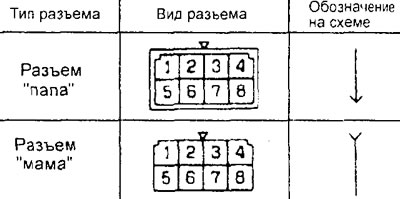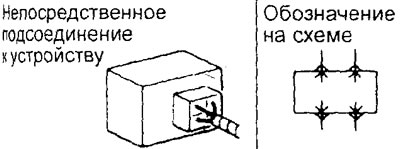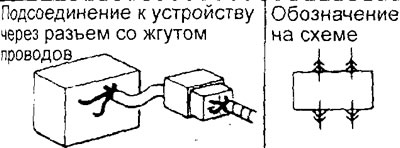How to use wiring diagrams
Each diagram is an image of a separate subsystem of electrical equipment from a fuse (or floating rate) before "masses". For ease of understanding the circuit, the power supply is shown at the top of the diagram, and "weight" - in the lower part.
A: Indicates the power source.
B: Indicates the wiring connection point number for another system that is connected to the system in question. Corresponds to the wiring connection point number shown on the diagram of the target system.
C: The name of the target system that has a link to the system in question.
D: If next to the connector number on the diagram there is no place to place its image, then the connector number is placed in the symbol and the connector itself is placed in another place.
E: Symbol "X" at the end of the connector number indicates that the connector is connected to the central junction point (e.g. relay box, etc.).
F:. In the case of connecting single-pole connectors, the pin number and connector number are omitted.
G: Indicates the operating conditions of the sensor (for example, a coolant temperature switch, etc.).
H: Indicates that the circuit continues at a point elsewhere in the diagram.


I: Indicates shielded wiring harness.
J: Indicates that the circuit continues to the next part of the wiring diagram.
K: Indicates the power supply in the control box. If the voltage is not specified, then it is considered equal to the voltage of the onboard network.
L: Indicates the jack number. It matches the connector number shown on the wiring harness diagram.
M: Indicates that the pin is a spare if it is a device (sensor in this case) is not receiving power according to specifications.
N: Indicates a connection point with "weight". (The dot number matches the number shown on the wiring harness and component location diagrams.)
A: Specifies the branching point of the wire where the cross section or color of the wire changes.
R: The direction of the current is indicated by an arrow. (In this case, the current is in both directions, up and down.)
Q: Indicates input/output signal (current direction) related to the electronic control unit.

R: In case two or more connectors are connected to the same device, the broken line (-) the pins of one connected connector are marked.
S: broken line (—) indicates that the pins refer to the same intermediate connector.
T: Indicates the pin number in the connector.
Designations of connectors, connections and components
1: Connector designation.

2: Connector pin numbering.
Connector pin numbering on the device side (for intermediate connector, connector side "dad") indicated when looking at the connector from the terminal side (on the connection side of the connector).

3: Indicates that the harness connector is connected directly to the device.

4: Indicates that the harness connector is connected to the device connector that includes the wiring.

5: Indicates an intermediate connector.

6: Indicates a connection to "weight" body.

7: Indicates a connection to "weight" devices (on the body of the device).

8: Indicates a connection to "weight" inside the electronic control unit.

Connector markings
Connectors are divided into groups according to their location on the vehicle and have a symbolic designation.
| Group | Location |
| A | Engine compartment |
| IN | Transmission |
| WITH | Front panel and instrument panel |
| D | Floor and roof |
| E | side doors |
| F | Backdoor |
Wire marking
The wires differ in the color of the insulation and the cross section of the conductive part, depending on which electrical devices they are connected to.
Table of symbols for electrical equipment components.

The diagrams show the marking of the wire with a letter code (see picture):

F: Wire type. («F» flexible wire, «T» twisted wire.)
1.25: Wire size in mm2. (If the value is not specified, then the wire section is 0.5 mm2. If the wire color code is given in brackets, then the wire cross section is 0.3 mm2.)
G: Primary wire color.
B: Optional wire color.
Color coding
1. Colors of wire insulation, colors of fuses and fuses.
Note: with a two-letter wire insulation color code (e.g. R.G) the first letter indicates the main color of the wire (red), and the second is the color of the strip on the wire (green).
| Code | Color | Code | Color |
| IN | black | ABOUT | orange |
| BR | brown | R | pink |
| G | green | R | red |
| GR | grey | V | violet |
| L | blue | W | white |
| LG | light green | Y | yellow |
| SB | blue | TRP | transparent |
2. The electrical circuit used, depending on the color of the wire insulation.
| Color | Electrical circuit |
| IN | Starting system and connection with "weight" |
| W | Charger |
| R | Lighting and light signaling |
| G Br | Signal circuits (sensors, etc.) |
| Y | Control devices, lamps, pointers |
| l | LG | ABOUT | Other |
Abbreviations
J / B: Fuse box in the cabin.
J/C: Jumper adapter (located in the front panel)
ACC: The power circuit starts to function when the ignition key is turned to the "ON" or "ACC".
IG1; The power circuit will function even when the ignition key is turned to the "ST".
IG2: The power circuit does not function when the ignition key is turned to the "ST".
GND: "Weight".
ILL: Illumination lamp.
IND: Pilot lamp (indication).
